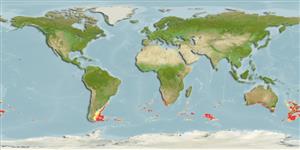>
Aulopiformes (Grinners) >
Notosudidae (Waryfishes)
Etymology: Scopelosaurus: Greek, skopelos = a lantern fish + Greek, sauros = lizard (Ref. 45335).
More on author: Waite.
Environment: milieu / climate zone / depth range / distribution range
Ekologi
laut bentopelagis; oceanodromus (Ref. 51243); kisaran kedalaman ? - 1000 m (Ref. 6602). Temperate; 30°S - 61°S
Atlantic, Indian and Pacific: in sub-Antarctic areas. Not known from the Southeast Pacific.
Size / Weight / umur
Maturity: Lm ? range ? - ? cm
Max length : 50.0 cm TL jantan/; (Ref. 6602)
deskripsi pendek
Morfologi | Morfometrik
Duri punggung (Keseluruhan (total)): 0; duri punggung lunak (Keseluruhan (total)): 10-13; Duri dubur 0; Sirip dubur lunak: 18 - 21. Dark brownish to blackish in color; paler below with no silvery scales; when specimen is without scales, an indistinct blackish anal spot of the peritoneum showing through the skin may be observed (Ref. 6602).
Larvae and juveniles pseudoceanic in midwater; adults taken by both bottom and pelagic trawls in about 600-800 m. Sub-adults and adults migrate to the Southern Ocean (to 60°S) to feed; on euphausiids, hyperiids, and other crustaceans as well as on small fishes, like myctophids; juveniles take small zooplankton, especially copepods.
Life cycle and mating behavior
Kematangan | Reproduksi, perkembang biakan | Pemijahan | telur-telur | Fecundity | Larva
Krefft, G., 1990. Notosudidae. p. 136-137. In O. Gon and P.C. Heemstra (eds.) Fishes of the Southern Ocean. J.L.B. Smith Institute of Ichthyology, Grahamstown, South Africa. (Ref. 5175)
Status IUCN Red List (Ref. 130435)
ancaman kepada manusia
Harmless
penggunaan manusia
Perikanan: tidak ada kepentingan
informasi lanjut
Nama-nama umumSinonim (persamaan)metabolismePemangsaEkotoksikologiReproduksi, perkembang biakanKematanganPemijahanSpawning aggregationFecunditytelur-telurpekembangan telor
Umur / SaizPertumbuhanpanjang-beratpanjang-panjangukuran frekuensiMorfometrikMorfologiLarvaDinamika larvapemulihanKelimpahanBRUVS
AcuanBudidaya airprofil budidaya airStrainGenetikaElectrophoresesDiturunkanPenyakit-penyakitPengolahanNutrientsMass conversion
mitraGambarStamps, Coins Misc.Suara-suaraCiguateraKecepatanTipe renangArea insangOtolithsOtakPenglihatan / visi
Alat, peralatan
laporan khas
muat turun XML
Sumber internet
Estimates based on models
Preferred temperature (Ref.
123201): 1.6 - 12.6, mean 7.1 °C (based on 276 cells).
Phylogenetic diversity index (Ref.
82804): PD
50 = 0.5001 [Uniqueness, from 0.5 = low to 2.0 = high].
Bayesian length-weight: a=0.00288 (0.00120 - 0.00692), b=3.18 (2.96 - 3.40), in cm total length, based on LWR estimates for this (Sub)family-body shape (Ref.
93245).
Trophic level (Ref.
69278): 3.4 ±0.40 se; based on food items.
Fishing Vulnerability (Ref.
59153): Moderate vulnerability (40 of 100).
